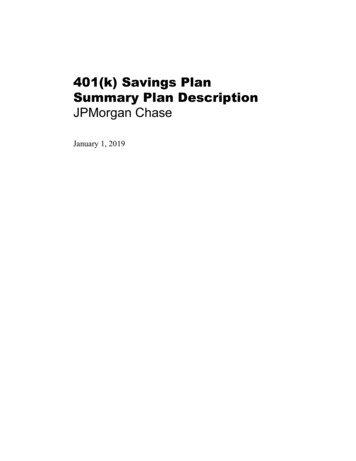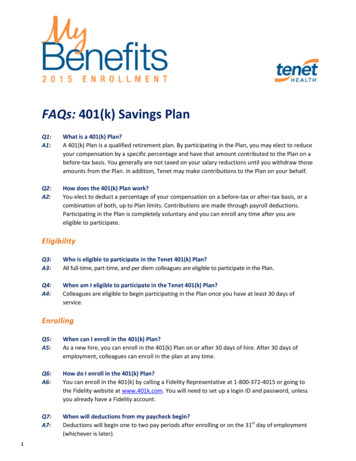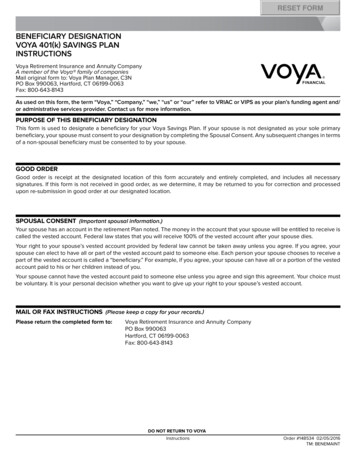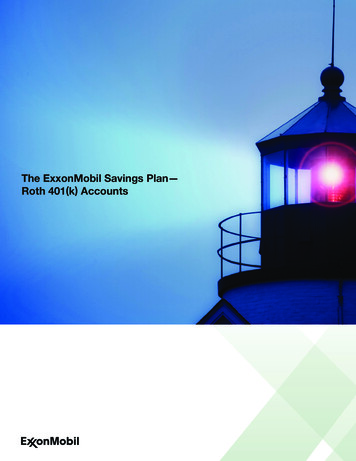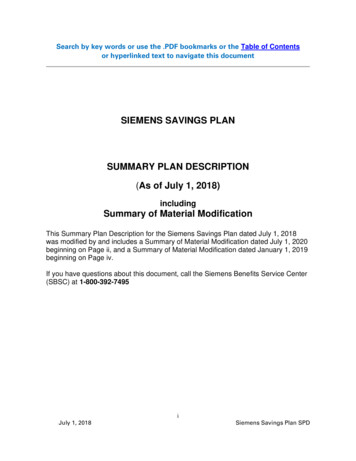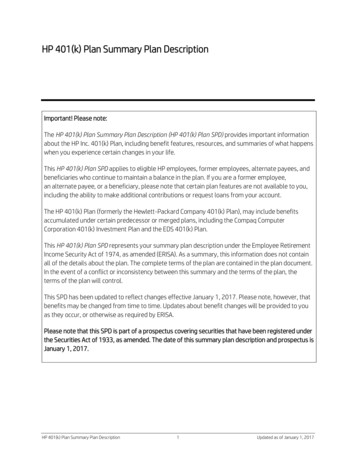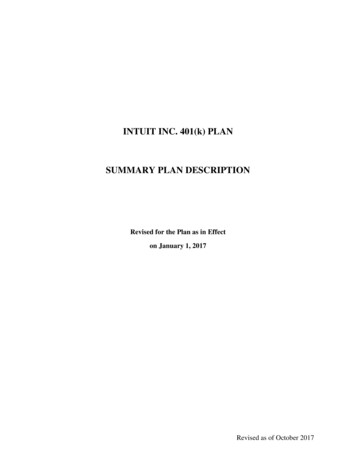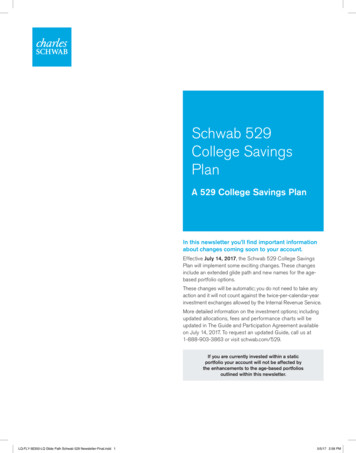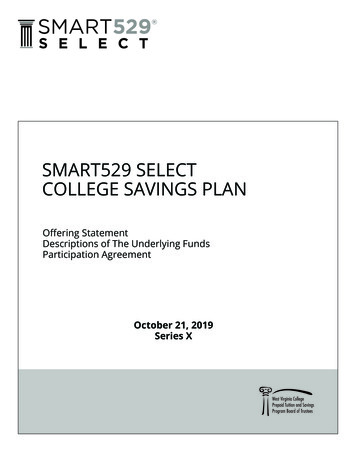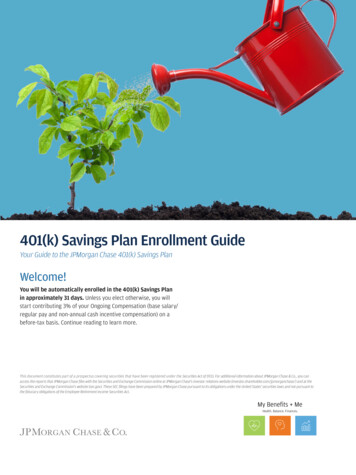
Transcription
401(k) Savings Plan Enrollment GuideYour Guide to the JPMorgan Chase 401(k) Savings PlanWelcome!You will be automatically enrolled in the 401(k) Savings Planin approximately 31 days. Unless you elect otherwise, you willstart contributing 3% of your Ongoing Compensation (base salary/regular pay and non-annual cash incentive compensation) on abefore-tax basis. Continue reading to learn more.This document constitutes part of a prospectus covering securities that have been registered under the Securities Act of 1933. For additional information about JPMorgan Chase & Co., you canaccess the reports that JPMorgan Chase files with the Securities and Exchange Commission online at JPMorgan Chase’s investor relations website (investor.shareholder.com/jpmorganchase/) and at theSecurities and Exchange Commission’s website (sec.gov). These SEC filings have been prepared by JPMorgan Chase pursuant to its obligations under the United States’ securities laws and not pursuant tothe fiduciary obligations of the Employee Retirement Income Securities Act.Health. Balance. Finances.
401(k) Savings Plan Enrollment GuideTable of contentsSection 1. 1Ways to contribute to the401(k) Savings PlanSection 2 . 2Saving begins automaticallyCongratulations! As an employee of JPMorgan Chase, you have theopportunity to participate in the JPMorgan Chase 401(k) Savings Plan,one of the best ways for you to prepare for your retirement.About this GuideBuilding a financially secure future is a partnership between you and JPMorgan Chase. That's why thefirm provides the 401(k) Savings Plan, one of the best and easiest ways to save for your retirement.Section 3 . 4Your contribution choicesThis Enrollment Guide highlights features of the 401(k) Savings Plan (Plan), including how yourparticipation in the Plan will begin automatically and the other choices you have available to you,including not participating in the Plan at all.Section 4 . 7Your investment choicesIt’s important that you carefully review this Enrollment Guide and make decisions that are right for you.Section 5 . 10About the 401(k) Savings PlanWeb CenterSection 6 . 12Fund informationSection 7 . 20Legal notices Fee Disclosure Notice . 20 2021 Notice ofAutomatic Enrollment . 28 Notice of Your RightsConcerning theJPMorgan Chase CommonStock Fund Under theJPMorgan Chase 401(k)Savings Plan .30 2021 QualifiedDefault InvestmentAlternative Notice . 31 Rollover instructions and form Special Tax NoticeContact informationAdditional Plan informationYou can access the following materials on the intranet or request a paper copy at no charge: Your JPMC Benefits Guide includes the Summary Plan Descriptions (SPDs) for the JPMorgan Chase U.S.Benefits Program, as well as the Plan prospectus. The Guide is available at jpmcbenefitsguide.com.You can also find the link at me@jpmc Benefits & Rewards Benefits & Rewards Home Your Guideto Benefits (SPDs). You can request a paper copy of the Guide via the HR Answers app on me@jpmc orby calling HR Answers. 401(k) Savings Plan Investment Fund Profiles brochure provides detailed information about yourinvestment choices under the Plan. This brochure is also available via the 401(k) Savings Plan WebCenter or Call Center.Beneficiary designationsIt is important to designate and maintain your beneficiaries in the 401(k) Savings Plan, as well asother U.S. Benefits Plans. JPMorgan Chase offers a convenient way to update this information throughthe Online Beneficiary Designations site, which you can access from work or from home:From work: me@jpmc Benefits & Rewards Benefits & Rewards Home View or Update BeneficiariesFrom home: http://beneficiary.jpmorganchase.comYou may return to this site at any time and update your beneficiaries as needed, for instance, if youhave a change in personal status (such as marriage, divorce or the birth/adoption of a child).My Finances and MeYou're immediately eligible to take advantage of My Finances and Me, a free financial well-beingprogram that provides you with: An online hub that includes a five-minute Financial Wellness Assessment and a myriad ofother resources Group education sessions Unlimited one-on-one telephonic financial coaching on any financial topicTo get started, visit the hub or call 1-833-283-0031 to speak with a Financial Coach Monday throughFriday from 9 a.m. to 8 p.m. Eastern time, except for certain U.S. holidays.Please note: Financial Coaches do not provide tax, legal, financial, or investment advice and cannotprovide any recommendations concerning the Plan.Note: WePay employees may not be able to access some of the intranet sites referenced in the Guide.
Section 1: Ways to contribute to the 401(k) Savings PlanYou can contribute to the 401(k) Savings Plan in two ways: through your Ongoing Compensation and your Annual Incentive Compensation.This section explains these terms and how you can maximize your contributions to the Plan.How much you canelect to contributeHow often you canchange this electionPer-pay (Standard)period election0% – 50% on abefore-tax and/orRoth basisThroughout the year.It will apply to the nextpaycheck as soon asadministratively possible.Annual IncentiveCompensation(Other) election0% – 50% on abefore-tax and/orRoth basisFrom the first businessday in March through thelast business day of thecalendar year.2N/AYour contributionsfrom OngoingCompensation andAnnual IncentiveCompensationcontinue until thetotal reaches thelegal limits oncontributions(see page 6)N/ACompensation you can contribute from:Election nameOngoing CompensationOngoing Compensation is your base salary/regular payand any non-annual cash incentive compensation.1(Please note: Automatic enrollment applies to yourOngoing Compensation only.) Annual Incentive CompensationAnnual Incentive Compensation is cash compensationawarded, if any, under the firm’s Performance-BasedIncentive Plan (generally paid in January) or BranchProfitability Incentive Plan (generally paid in February). Eligible CompensationEligible Compensation is the sum of your OngoingCompensation and Annual Incentive Compensation andis used when calculating company contributions, such asannual automatic pay credits and matching contributions,for eligible employees (see page 5 for more information).Eligible Compensation does not include overtimepayments, sign-on bonus and similar awards, referralawards, stipends, non-cash awards (such as equityawards) and allowances.Non-annual cash incentive compensation includes cash incentives that are paid throughout the year, such as sales awards and monthly and quarterly incentives. It alsoincludes any cash incentives paid annually other than Annual Incentive Compensation.12The election on file as of the last business day of the calendar year is irrevocable and will be applied to the cash portion of any Annual Incentive Compensation you mayreceive the following January (or February). Please note: If you are subject to a quarterly window period and you have an investment election on file to direct futurecontributions to the JPMorgan Chase Common Stock Fund, you may only make an election during an open window period.JPMorgan Chase 401(k) Savings Plan Enrollment Guide1
Section 2: Saving begins automaticallyJPMorgan Chase is here to help make enrolling in the Plan and saving for your retirement as easy as possible. Unless you enroll on your own,you will be automatically enrolled in the 401(k) Savings Plan at the end of your 31-day grace period. Your default elections will be as follows: You will begin contributing 3% of your Ongoing Compensation (generally base salary/regular payand any non-annual cash incentives) through before-tax payroll deductions. Please note: Automaticenrollment does not apply to the cash portion of your Annual Incentive Compensation (if any). This contribution rate will increase by 1% annually until you reach 10%. Your contributions will be invested in a Target Date Fund based on your age and an assumedretirement age of 65, unless you choose other investments. Please refer to the “Qualified DefaultInvestment Alternative Notice” on page 31 in this Guide for details on which fund is your correctdefault investment fund.While you do not need to make any enrollment decisions, you may want to consider these questions:Are these the right choices for you?1. If you do nothing, your 3% contributions will begin shortly after your grace periodends. Keep in mind that within the 401(k) Savings Plan, you have the flexibility to domuch more. For example, you may choose to contribute a different amount or selectdifferent investments. This is an important part of your retirement savings, andit’s up to you to decide how much to save and how you want to invest. Rememberthat once payroll deductions begin, you can stop or change them at any time goingforward. For more information, please review the “Notice of Automatic Enrollment”and the “Qualified Default Investment Alternative Notice” included in this Guide.The grace periodYour participation in the Planis automatic at the end of your31-day “grace period.” Yourgrace period begins when youfirst become eligible for thePlan. For full-time employees(those regularly scheduled towork 40 hours per week), thisis your hire date and, if you’rea part-time employee (thoseregularly scheduled to workbetween 20 and 39 hours perweek), it is the first of the monthfollowing completion of 60 daysof service.Would you prefer to make your own savings and investing decisions?2. You may wish to make other choices for your savings — or to enroll in the Plan sooner than the end of your grace period.To become familiar with your options within the 401(k) Savings Plan, read this Enrollment Guide. It provides informationon the Plan’s extensive benefits and features to help you make wise decisions for your long-term saving goals.If you do not wish to join the PlanIf you do not wish to participate, you can “opt out” of the Plan by simply accessing the 401(k) Savings Plan Web Centeror contacting the 401(k) Savings Plan Call Center. If you choose to opt out, you must make this election within your31-day grace period. Before opting out, please continue reading and make sure you understand all of the reasons tostart saving now.Once your enrollment is effective, you can stop contributing or change the amount you are contributing on a prospective basis only (keep inmind that it may take one to two pay periods for contributions to stop). The Plan will not issue refunds for 401(k) payroll deductions, and anycontribution amounts will remain in the 401(k) Savings Plan. If you want to make changes to the default elections, access the 401(k) Savings PlanWeb Center or contact the 401(k) Savings Plan Call Center. Do not contact the payroll department.Example of automatic enrollmentIf you are a full-time employee hired on August 1, you will have until September 1 before you become enrolled in the Plan automatically.During that 31-day grace period, you can decide whether joining the Plan is right for you. If you do nothing by the end of the grace period(September 1), you will see your first 3% contribution withheld from your pay in mid-September. Then, each year your contribution will increaseautomatically by 1% until you reach 10%.2JPMorgan Chase 401(k) Savings Plan Enrollment Guide
The benefits of saving todayQuick tipRetirement may seem like a distant need, and it can be a difficult concept to reconcile givenday-to-day demands. But when you consider that you could spend upwards of 20 years inretirement with no steady income, it underscores the importance of saving earlyand consistently.That’s where the 401(k) Savings Plan comes in. The Plan makes it convenient to save throughpayroll deductions, so you don’t have to go to the effort to set aside the money on your own.And it’s a tax-effective way to save through either before-tax or Roth contributions — or both.Plus, by contributing up to 5% of Eligible Compensation,you can take advantage of the dollar-for-dollar companymatching contribution after completing one year of service(if eligible3). There’s no better incentive to save!You’re eligible for the company match after one year of service provided your Total Annual Cash Compensationis less than 250,000. Only contributions made, and compensation earned, after one year of service arematch eligible.3The earlier you start saving, the longer your money can work for you. This is the basis forcompounding. The money you earn on your contributions gets reinvested in the Plan, andthat money has the potential to grow over time. There can be a considerable difference justby starting early. For example, Jane and John both contribute the same amount ( 80 permonth) for 20 years and both receive 960 in company matching contributions a year. Janestarts early at 22 and then stops at 42, while John starts at 45 and continues until age 65.The power of compounding makes a difference worth 139,000.At age 65: Jane’s total – 203,600John’s total – 64,600John’s cost of waiting? 139,000Interested in gaining insight into themoney that may be available to youwhen you retire? When you go to the401(k) Savings Plan Web Center, you’llautomatically see a snapshot of yourestimated income in retirement. Seepage 10 for more information.Important information forrehired employeesIf you were previously employed withJPMorgan Chase within the last 31 days, yourcontribution rate and investment elections (ifany) will be reinstated as of your first pay. Ifyou were eligible for automatic pay credits,you will receive automatic pay credits based onthe same percentage of Eligible Compensation(capped at 100,000 annually) as you wouldhave otherwise received had you not had abreak in service.If you were previously employed with the firmbut your break in service is greater than 31days, you will be treated by the 401(k) SavingsPlan as a newly hired employee, and youwill be subject to automatic enrollment at abefore-tax contribution rate of 3%. Generally,your contributions will be invested in a TargetDate Fund based on your age and an assumedretirement age of 65.Your investment elections for this Plan willremain active even if you no longer have abalance in the Plan. If you are rehired, yourprevious investment elections will still be validand apply to any new contributions unless youset up new investment elections.To verify your investment elections, please callthe 401(k) Savings Plan Call Center. As with allother newly hired employees, you will have thechance to opt out of contributing to the 401(k)Savings Plan within 31 days from your mostrecent hire date.Jane’s contribution periodJohn’s contribution periodFOR ILLUSTRATIVE PURPOSES ONLY. The hypothetical illustration above is not intended as a projection or prediction of futureinvestment results, nor is it intended as financial planning or investment advice. It assumes a 5% annual rate of return andreinvestment of earnings with no withdrawals. Rates of return may vary. The illustration does not reflect any associated charges,expenses or fees. The tax-deferred accumulation shown would be reduced if these fees were deducted.If your break in service is less than five years,the value of any forfeited JPMorgan Chasematching and non-matching contributionsis restored — provided that you repay anyamounts distributed to you during your breakin service. Please contact the 401(k) SavingsPlan Call Center for information on restoring anyforfeitures to your account.JPMorgan Chase 401(k) Savings Plan Enrollment Guide3
Section 3: Your contribution choicesRemember, you will be automatically contributing 3% of Ongoing Compensation on a before-tax basis, butyou don’t need to stop there. Within the 401(k) Savings Plan, you can change how much you save and thetype of contribution — whether before-tax or Roth — at any time, as well as contribute from any AnnualIncentive Compensation you receive. Plus, the sooner you increase your contributions to 5% of OngoingCompensation and 5% of Annual Incentive Compensation, the sooner you can start maximizing thematching contribution (if eligible). Following are the other saving options and features from which youcan choose.Types of contributions Before-tax contributions: Contributions you can make before federal — and in most cases — state and local income taxes are withheld.Before-tax contributions lower your current taxable income during the year the contributions are made. Roth after-tax contributions: Contributions you can make on an after-tax basis, which means federal, state and local income taxes havealready been withheld. Roth contributions do not lower your current taxable income during the year in which contributions are made.However, any associated investment earnings can later be withdrawn tax-free, assuming certain criteria are met.You have the flexibility to contribute differently during the year depending on what works best for you. There are two types of 401(k)contribution rates: Ongoing Compensation and Annual Incentive Compensation. As noted on page 1 of this Guide, you may contributeto the 401(k) Savings Plan from your Ongoing Compensation (this is referred to as your per-pay (Standard) rate on the “My Contributions”screen of the 401(k) Savings Plan Web Center) and/or your Annual Incentive Compensation (this is referred to as your Annual IncentiveCompensation (Other) rate up to the annual legal limits (see page 6).Set your contributions to automatically increaseEven if you choose to take a hands-on approach with your savings, you may wish to put yourcontributions on automatic increase. With this feature, you can elect to have your before-taxand/or Roth contribution rate for your per-pay contributions increase annually by a certainpercentage without having to remember to elect that increase every year. It’s like putting yourcontribution increases on auto pilot.Here’s how it works: You choose the percentage, as well as the month and year, you wish theincrease to begin. Once you elect automatic increase, your contribution increase will happenautomatically at the same time each year. It continues until you reach the percentage set by you(the dollar amount of your contribution will be capped at the annual Internal Revenue Servicelimit). You can turn the feature off when you wish, or when you reach your savings goal.Example: Let’s say you are currently contributing 6% from your Ongoing Compensation to your401(k) Savings Plan account. You elect to automatically increase your contributions by 1% eachJanuary until your contributions reach 12%. Your contribution rate will increase as follows: January 2022: 7% January 2023: 8% January 2024: 9% January 2025: 10% January 2026: 11% January 2027: 12%Quick tip: You can model how changing your savings rate(s) might affect your future estimatedretirement income on the 401(k) Savings Plan Web Center.4JPMorgan Chase 401(k) Savings Plan Enrollment GuideSaver’s CreditCertain individuals may be eligibleto receive a saver’s credit of up to 2,000 ( 4,000 if married and filingjointly) for contributing to qualifiedtax-deferred retirement plans, suchas the 401(k) Savings Plan. Thesecredits are limited to individualswhose adjusted gross income (AGI)is less than or equal to the followingamounts for 2021: 66,000 for couples filing incometaxes jointly; 49,500 for individuals who fileas heads of household; and 33,000 for single taxpayers.For more information, pleasecontact your personal financialplanner, tax advisor or otherqualified financial professional.
Automatic pay credits contributed by JPMorgan ChaseAfter one year of total service, you will be eligible for automatic pay credits equal to 3% ofEligible Compensation4 (capp
Congratulations! As an employee of JPMorgan Chase, you have the opportunity to participate in the JPMorgan Chase 401(k) Savings Plan, one of the best ways for you to prepare for your retirement. About this Guide . Building a financially secure future is a par
